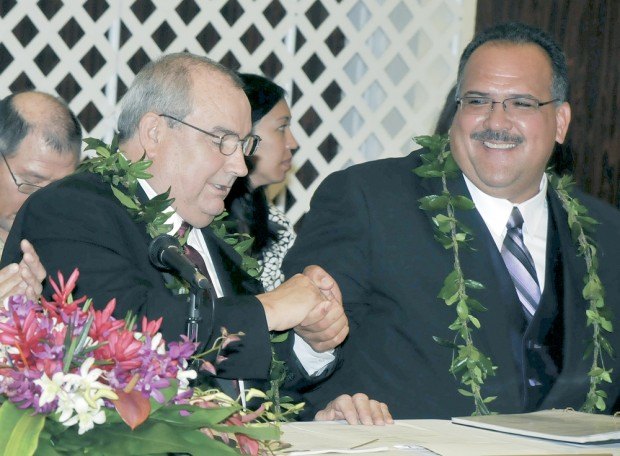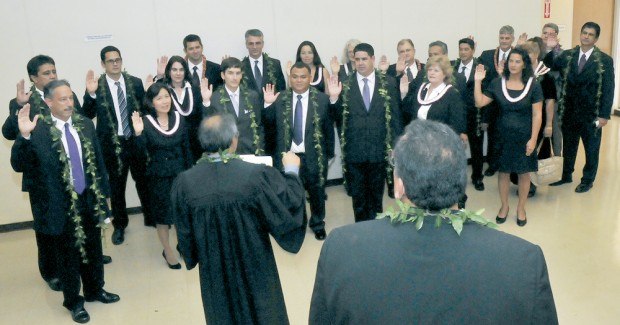LIHU‘E — Recently re-elected Mayor Bernard Carvalho Jr. drew a standing ovation at his inauguration ceremony, after a speech that revealed many grand plans for the island in the next 10 years. “It’s an amazing feeling to stand before you
LIHU‘E — Recently re-elected Mayor Bernard Carvalho Jr. drew a standing ovation at his inauguration ceremony, after a speech that revealed many grand plans for the island in the next 10 years.
“It’s an amazing feeling to stand before you today and accept the responsibility of serving as your mayor for the next four years,” Carvalho told hundreds who came to the inauguration of the mayor and county council at the Kaua‘i War Memorial Hall on Wednesday afternoon.
The crowd came appropriately dressed in gala for the event, eager to hear what Carvalho and the new County Council Chair Jay Furfaro, had to say.
Carvalho said much of his successes in the past two years as mayor were “just the final touches on the great and visionary work Bryan (Baptiste) did as a public servant.”
Baptiste was in his second term as a mayor when he died June 22, 2008. A special election chose Carvalho as mayor for the rest of Baptiste’s term, which ended this year.
Carvalho may have called Baptiste’s work “visionary,” but the mayor’s speech set an equally ambitious future for Kaua‘i.
Announcing he decided to take the audience on a “virtual tour” of the island, Carvalho said it would be a tour of what Kaua‘i could be, and what he would like to believe it will be, 10 years from now.
“I call this ‘Holo Holo 2020.’ Are you with me?” Carvalho asked the audience.
Carvalho’s tour started at sunset at Ke‘e Beach. There would be no cars parked there, because a shuttle from Princeville to Ke‘e would be in operation.
He would jump in the shuttle and meet with Furfaro at Hanalei Beach, which has been transformed by an additional 10 acres added in the past 10 years.
Carvalho then would get back in the shuttle, heading up to Princeville.
“And by the way, mahalo to Princeville Corp. for donating the land for the shuttle service,” Carvalho said.
In Princeville, Carvalho would get into his electric car, which would have been charging at the shuttle lot.
He would stop in at the Kilauea farmers’ market, at the corner of the Kilauea agriculture park, which would be open seven days a week.
In Anahola he would see inspectors signing off on the latest batch of homes for Native Hawaiians.
Going down the highway, Carvalho would drive past Kaiakea fire station, located between Kealia Beach and Kapa‘a. In 2011 Kaiakea will be county’s first LEED-certified (Leadership in Energy and Environmental Design) fire station, he said.
“But 10 years in the future, it’s now our oldest LEED-certified building, because we have several that meet that standard,” Carvalho said.
Kapahi would have safe routes to school, and the majority of the children would walk to school safely, he said.
In Kapa‘a, Carvalho would get on a bicycle and ride the coastal path, which would then extend for 15 miles.
The portion of the highway passing through Kapa‘a and Wailua would be widened, and hybrid buses packed with passengers would be moving on schedule, causing the traffic to flow steadily.
Wailua’s Lydgate Beach Park would be “beautifully maintained,” and in Hanama‘ulu a group of seniors would be exercising on the lawn of the neighborhood center.
The Lihu‘e Town Core Plan would already be implemented, and there would be people enjoying a lawn that would extend from the Lihu‘e Civic Center’s Mo‘ikeha Building to the Historic County Building.
The development of the resource recovery park and landfill site in Kalepa (Kapaia) would result in the addition of 1,000 acres of agricultural land, because the county, the state and Grove Farm would have worked together to restore the stable storm-irrigation system.
Carvalho would then hop back on the bus and keep going south.
The Kaua‘i Community College would have four-year degrees, plus advanced degrees.
In Po‘ipu the Kaneiolouma Heiau would have been “fully restored and diligently maintained” by the Hui Malama o Kaneiolouma, the first Native Hawaiian group to have entered into a stewardship agreement with the county.
In Kalaheo almost every building would have solar or photovoltaic panels.
All of the bus shelters would have roofs in 2020, Carvalho said.
Still on the bus, as he would ride through Hanapepe and Waimea, Carvalho would be struck by the fact that these towns have maintained their character over the past 10 years. But the efforts to work with local merchants and business associations on economic-development projects would have resulted in sidewalks filled with customers.
In Kekaha, there would be no longer a landfill, and the gardens park would be finally complete.
The road to Koke‘e would be “immaculately paved,” Carvalho said.
Carvalho would ride the bus late in the evening back to Kapahi, because in 2020 the services would run until late into the night.
“Holo Holo 2020 is a vision I hope we can achieve,” Carvalho said. “It may not all be complete 10 years from now, but it could all be in motion.”
At the end of his inaugural address Carvalho received a long standing ovation from the audience, which included many state senators and prominent politicians.
Tomorrow: County council addresses



